Pten inhibition dedifferentiates long-distance axon-regenerating intrinsically photosensitive retinal ganglion cells and upregulates mitochondria-associated Dynlt1a and Lars2
- PMID: 37039265
- PMCID: PMC10163351
- DOI: 10.1242/dev.201644
Pten inhibition dedifferentiates long-distance axon-regenerating intrinsically photosensitive retinal ganglion cells and upregulates mitochondria-associated Dynlt1a and Lars2
Abstract
Central nervous system projection neurons fail to spontaneously regenerate injured axons. Targeting developmentally regulated genes in order to reactivate embryonic intrinsic axon growth capacity or targeting pro-growth tumor suppressor genes such as Pten promotes long-distance axon regeneration in only a small subset of injured retinal ganglion cells (RGCs), despite many RGCs regenerating short-distance axons. A recent study identified αRGCs as the primary type that regenerates short-distance axons in response to Pten inhibition, but the rare types which regenerate long-distance axons, and cellular features that enable such response, remained unknown. Here, we used a new method for capturing specifically the rare long-distance axon-regenerating RGCs, and also compared their transcriptomes with embryonic RGCs, in order to answer these questions. We found the existence of adult non-α intrinsically photosensitive M1 RGC subtypes that retained features of embryonic cell state, and showed that these subtypes partially dedifferentiated towards an embryonic state and regenerated long-distance axons in response to Pten inhibition. We also identified Pten inhibition-upregulated mitochondria-associated genes, Dynlt1a and Lars2, which promote axon regeneration on their own, and thus present novel therapeutic targets.
Keywords: Axon growth; Mouse; Optic nerve; Retinal ganglion cell; scRNA-seq.
© 2023. Published by The Company of Biologists Ltd.
Conflict of interest statement
Competing interests The authors declare no competing or financial interests.
Figures
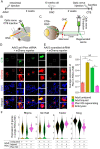
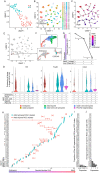
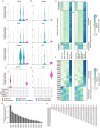
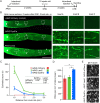
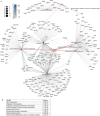
Similar articles
-
Three-dimensional evaluation of retinal ganglion cell axon regeneration and pathfinding in whole mouse tissue after injury.Exp Neurol. 2013 Sep;247:653-62. doi: 10.1016/j.expneurol.2013.03.001. Epub 2013 Mar 16. Exp Neurol. 2013. PMID: 23510761 Free PMC article.
-
Sustained axon regeneration induced by co-deletion of PTEN and SOCS3.Nature. 2011 Nov 6;480(7377):372-5. doi: 10.1038/nature10594. Nature. 2011. PMID: 22056987 Free PMC article.
-
Monocyte-derived SDF1 supports optic nerve regeneration and alters retinal ganglion cells' response to Pten deletion.Proc Natl Acad Sci U S A. 2022 Apr 12;119(15):e2113751119. doi: 10.1073/pnas.2113751119. Epub 2022 Apr 8. Proc Natl Acad Sci U S A. 2022. PMID: 35394873 Free PMC article.
-
Lab review: Molecular dissection of the signal transduction pathways associated with PTEN deletion-induced optic nerve regeneration.Restor Neurol Neurosci. 2019;37(6):545-552. doi: 10.3233/RNN-190949. Restor Neurol Neurosci. 2019. PMID: 31839616 Free PMC article. Review.
-
Advances in experimental optic nerve regeneration.Curr Opin Ophthalmol. 2017 Nov;28(6):558-563. doi: 10.1097/ICU.0000000000000417. Curr Opin Ophthalmol. 2017. PMID: 28795960 Review.
Cited by
-
Intranasal delivery of small extracellular vesicles reduces the progress of amyotrophic lateral sclerosis and the overactivation of complement-coagulation cascade and NF-ĸB signaling in SOD1G93A mice.J Nanobiotechnology. 2024 Aug 22;22(1):503. doi: 10.1186/s12951-024-02764-2. J Nanobiotechnology. 2024. PMID: 39174972 Free PMC article.
-
Retinal ganglion cell repopulation for vision restoration in optic neuropathy: a roadmap from the RReSTORe Consortium.Mol Neurodegener. 2023 Sep 21;18(1):64. doi: 10.1186/s13024-023-00655-y. Mol Neurodegener. 2023. PMID: 37735444 Free PMC article. Review.
-
Experimental upregulation of developmentally downregulated ribosomal protein large subunits 7 and 7A promotes axon regeneration after injury in vivo.Exp Neurol. 2023 Oct;368:114510. doi: 10.1016/j.expneurol.2023.114510. Epub 2023 Aug 24. Exp Neurol. 2023. PMID: 37633482 Free PMC article.
-
Upregulation of developmentally-downregulated miR-1247-5p promotes neuroprotection and axon regeneration in vivo.Neurosci Lett. 2024 Feb 16;823:137662. doi: 10.1016/j.neulet.2024.137662. Epub 2024 Jan 28. Neurosci Lett. 2024. PMID: 38286398 Free PMC article.
-
A miR-383-5p Signaling Hub Coordinates the Axon Regeneration Response to Inflammation.J Neurosci. 2024 Oct 30;44(44):e1822232024. doi: 10.1523/JNEUROSCI.1822-23.2024. J Neurosci. 2024. PMID: 39266301 Free PMC article.
References
-
- Blackmore, M. G., Wang, Z., Lerch, J. K., Motti, D., Zhang, Y. P., Shields, C. B., Lee, J. K., Goldberg, J. L., Lemmon, V. P. and Bixby, J. L. (2012). Krüppel-like Factor 7 engineered for transcriptional activation promotes axon regeneration in the adult corticospinal tract. Proc. Natl. Acad. Sci. USA 109, 7517-7522. 10.1073/pnas.1120684109 - DOI - PMC - PubMed
Publication types
MeSH terms
Substances
Grants and funding
LinkOut - more resources
Full Text Sources
Medical
Molecular Biology Databases
Research Materials

